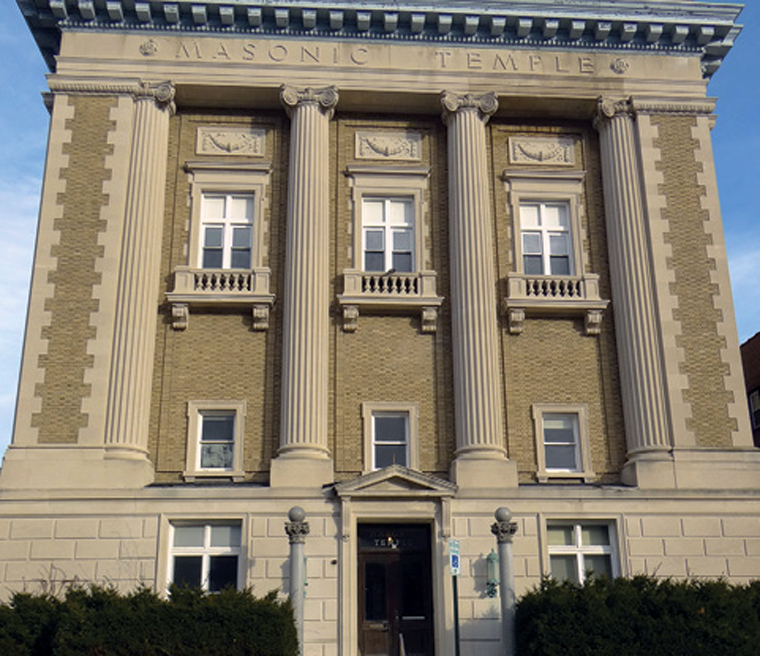A plan from SUNY Orange to revitalize part of downtown Newburgh and provide new educational opportunities for the city”™s residents got a big boost at the end of 2018.
The Newburgh- and Middletown-based community college”™s plan, called Innovation Grand Street, was awarded $1.83 million in state grant funding through the annual Consolidated Funding Application cycle in December. The grant, from Empire State Development, will help fund the renovation of three buildings on Grand Street, just a block away from Newburgh City Hall. The buildings will become a home for workforce development training and entrepreneurial courses from the college.
SUNY Orange President Kristine Young called the grant a “shot in the arm” for the effort.
“We have the validation at that level that we are on the right track. The state believed we can do the work,” Young said. “We know we can do the work, but the state believing we can do the work is huge.”

The stretch of brick and stone buildings, each built in the early 20th century, include the former Masonic Lodge building at 48 Grand St., the former American Legion building at 62 Grand St. and a former YMCA building at 54 Grand St. Orange County acquired the three buildings ”” totaling 78,000 square feet ”” for $3.5 million in 2013, with plans for future use by the college.
The buildings are next door to SUNY Orange”™s Newburgh campus and offer a chance to extend the college”™s downtown presence to a full block. Young arrived as president of the college in the summer of 2015, and began research and community outreach to find ways the buildings could serve city residents.
The college has since developed a plan it hopes will revitalize the downtown while training people to improve their lives. The effort can then also help the city”™s employers gain skilled workers.
“We know we are recognized as an anchor institution in the city, so we really wanted to live up to that designation and do something of vital importance,” Young said.
The college asked itself, she added, whether Newburgh”™s workforce is “prepared for the continuing changeover from an agrarian community to what Orange County is becoming.”
The three buildings will offer programs and more short-term learning opportunities beyond SUNY Orange”™s current offerings. “They will be very accessible, particularly for the citizens of Newburgh,” Young said. “People can come in, be educated and gain meaningful employment not far from home.”
SUNY Orange plans to focus its programming on four sectors: entrepreneurship and innovation; food, beverage and entertainment; health care and wellness; and creative design and historic preservation.
For the food, beverage and entertainment sector, Young cited Orange County”™s strong tourism economy, likely to grow further with the planned opening of the Northeast”™s only Legoland amusement park in 2020. Workforce development efforts would also target growing sectors such as craft beverages and food chain management.
The county”™s health care industry is also growing, and Young notes SUNY Orange has a long history of strong health care education programs. Innovation Grand Street could help expand those programs to train people for health care professions.
The focus on the historic preservation sector is a nod to Newburgh”™s history, the city being founded in 1709. Newburgh has a number of preserved historic properties, with growing momentum for new restoration projects, according to Young.
“We hear constantly that there are not enough skilled craftspeople or construction people who know how to work with these buildings,” Young said. “Everything from the doorknobs to the moldings that is required to bring these buildings back.”
Those sectors will connect with the initiative’s focus on training people for entrepreneurship, Young said. Programming will target “people who maybe did not have to go into higher education a decade or two ago, but have a desire to own their own business or spin up an idea in any of those sectors.”
She added, “not only are we training people to join the workforce in those sectors, but if someone wants to come in and do something themselves to add to a sector, they”™ll have the tools.”
While many of the courses may last only 12 weeks before hopefully creating an opportunity for employment, the training could also count toward a degree program at SUNY Orange or another college, Young said.
While the state grant gives the project a boost, there”™s still much work to be done. Fundraising and grant finding will continue from SUNY Orange, as well as its affiliated SUNY Orange Foundation and Orange County Community College Association.
Restoration work on the buildings in the first phase ”” 48 Grand St. and 62 Grand St. ”” will start this year, while work at the former YMCA building at 54 Grand St. will wait for a second phase. The first phase is estimated to cost $9.16 million, while the school has not calculated a cost for the total project.
SUNY Orange is also organizing a public-private partnership with local employers to fund equipment and programming necessary to Innovation Grand Street. Young hopes by 2020 there will be programming in the buildings, supported by the public-private partnerships.
The efforts are already gaining momentum beyond the first state grant. Weeks after receiving the $1.83 million Empire State Development grant, the college announced it won another $200,000 facilities grant from the Dormitory Authority of the State of New York.





















